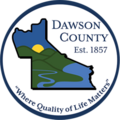Dawson County, Georgia | |
|---|---|
 Dawson County Courthouse in Dawsonville | |
 Location within the U.S. state of Georgia | |
| Coordinates: 34°26′N84°10′W / 34.44°N 84.17°W | |
| Country | |
| State | |
| Founded | 1857 |
| Named after | William Crosby Dawson |
| Seat | Dawsonville |
| Largest city | Dawsonville |
| Area | |
• Total | 214 sq mi (550 km2) |
| • Land | 211 sq mi (550 km2) |
| • Water | 3.6 sq mi (9.3 km2) 1.7% |
| Population (2020) | |
• Total | 26,798 [1] |
| Time zone | UTC−5 (Eastern) |
| • Summer (DST) | UTC−4 (EDT) |
| Congressional district | 6th |
| Website | www |
Dawson County is a county in the Northeast region of the U.S. state of Georgia. As of the 2020 census, the population was 26,798 up from 22,330 in 2010. [2] [1] The county seat is Dawsonville. [3]
Contents
- History
- American Civil War
- Post-Civil War to present
- Education
- Geography
- Adjacent counties
- National protected area
- Communities
- Cities
- Unincorporated communities
- Private communities
- Demographics
- 2020 census
- 2010 census
- 2000 census
- Politics
- Transportation
- Major highways
- Pedestrians and cycling
- Notable people
- See also
- References
- External links
Dawson County is included in the Atlanta metropolitan statistical area. Its natural resources include Amicalola Falls, the highest falls in Georgia and one of the Seven Natural Wonders of the state.




